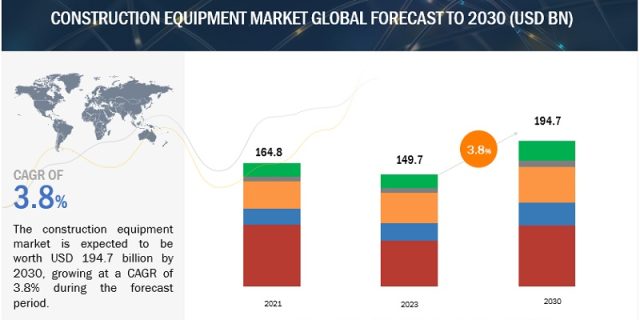
The construction equipment market is forecasted to grow significantly, reaching an estimated value of $194.7 billion by the year 2030. This growth is driven by increasing urbanization, infrastructure development, and advancements in technology, which are boosting demand across various regions. Factors such as government investments in public infrastructure projects and the rising trend of automation in construction activities are also contributing to this market expansion. Key players in the industry are focusing on innovative solutions and sustainable practices to meet the evolving needs of the construction sector.
Government investments in large-scale public infrastructure projects, such as highways, railways, and airports, are also playing a crucial role in the expansion of the construction equipment market. In addition, the rising trend of smart city initiatives is necessitating the use of sophisticated construction equipment to build modern urban infrastructures.
Key Drivers Fueling Growth in the Construction Equipment Market
Accelerated Urbanization and Infrastructure Expansion
The surge in urbanization, especially in developing regions, is creating an unprecedented demand for robust infrastructure. Countries across Asia-Pacific, Latin America, and Africa are investing heavily in essential construction projects, from highways to urban transit systems, to support their booming urban populations. This infrastructure boom is significantly driving the need for advanced construction equipment.
2. Robust Government Investments and Initiatives
Governments around the globe are prioritizing infrastructure as a cornerstone of economic growth, channeling substantial investments into public projects. Large-scale developments in transportation networks, airports, and smart city initiatives are generating immense opportunities for the construction equipment market. These strategic government interventions are crucial in fostering market growth.
3. Breakthrough Technological Innovations
Technological advancements are at the forefront of revolutionizing the construction equipment industry. The introduction of autonomous machinery, GPS-enabled telematics, and integrated control systems is enhancing operational efficiency, safety, and precision in construction activities. These innovations are not only boosting productivity but also driving cost reductions and mitigating environmental impacts.
4. Growing Emphasis on Sustainable Practices
The increasing focus on sustainability and stringent emission regulations are pushing the industry towards greener practices. Manufacturers are responding by developing electric and hybrid construction equipment, aimed at reducing carbon footprints and complying with environmental standards. This shift towards sustainable solutions is gaining momentum, driven by regulatory demands and consumer preferences.
5. Expansion of the Equipment Rental Market
The rental market for construction equipment is witnessing significant growth as companies look for cost-effective solutions. Renting machinery offers flexibility, reduces maintenance costs, and alleviates the financial burden of equipment ownership. This trend is playing a pivotal role in the overall expansion of the construction equipment market.
Download PDF Brochure @ https://www.marketsandmarkets.com/pdfdownloadNew.asp?id=179948937
Construction Equipment Market Ecosystem.
The construction equipment ecosystem comprises component suppliers, assembly lines, distribution and service, rental service components, and end users.
The ecosystem comprises component suppliers who supply engines and drivetrains and specialized suppliers for boom and cabin. These components are assembled at the second level of the ecosystem. This stage brings together components for the assembly and fabrication of construction equipment. At the distribution and service level, the dealer sells construction equipment independently without the intervention of the manufacturers.
Manufacturers directly deal with construction companies for sales. Rental services include construction equipment manufacturers who undertake both sales of new equipment and rental services, and the end user completes the ecosystem
Asia Pacific is estimated to be the dominant regional market.
Asia Pacific is projected to lead the global Construction Equipment market by 2028. The dominance is mainly due to China which is predicted to be the largest market in Asia. Growing infrastructure development activities like constructing railway lines, road constructions, new commercial complexes, and others would drive the future demand for construction equipment like Crawler Excavators and road rollers.
According to Off-Highway research, in 2023, it is expected that there will be broadly based growth in equipment sales, and the Indian market is predicted to increase by 10%. Several proposals for infrastructure investment drive this growth. One of the key factors influencing the demand for construction equipment is the increasing demand for compact construction equipment. The JCB and Tata Hitachi, the executives in India’s compact construction equipment market, cater to this demand. In 2022, these manufacturers were top suppliers of compact construction equipment in India and catered to the 50% demand.
Key Market Players & Start-ups
The construction equipment market is dominated by players such as Caterpillar (US), Komatsu Ltd. (Japan), Hitachi Construction Machinery Co., Ltd. (Japan), Xuzhou Construction Machinery Group (China), and SANY Group (China). These companies have strong distribution networks at the global level.
Request Free Sample Report @ https://www.marketsandmarkets.com/requestsampleNew.asp?id=179948937

